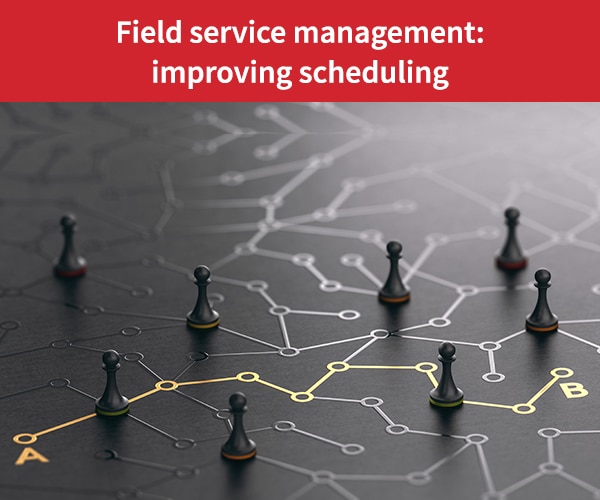
- Field Service Management
- Optimization
- Predictive Maintenance
Keeping Medical Equipment Up and Running for Those Whose Lives Depend on it
Each country’s healthcare system is directly linked to its economy. It makes up a substantial part of society’s critical infrastructure and involves a large network of people and institutions coming together to improve the health of citizens through medicine and specialised equipment. Technology and healthcare work hand-in-hand. Doctors and medical practitioners can’t possibly do their jobs without the help of medical devices, used to diagnose health problems as well as provide support for and monitor issues over time. It is increasingly important to maintain equipment efficiency to provide the best level of care to patients dependent on it. For example, many of these specialised devices are used in life-threatening situations. Defibrillators are required to restore a normal heartbeat in a patient experiencing sudden cardiac arrest. Anesthesia machines provide an accurate supply of general anesthesia to those undergoing a medical procedure. These types of equipment are indispensable and can’t afford to fail. It is a matter of life, and death.
The severity of regular maintenance for medical devices
In heavily regulated industries such as healthcare, medical devices must be routinely maintained to ensure they’re fully operational and run smoothly and safely without fail. When you’re dealing with people’s lives, medical mistakes caused by faulty or unusable equipment must be avoided at all costs. Health institutions need to be able to count on reliable service companies that offer regular maintenance of medical equipment parts to protect their expensive investments, limit emergency repair calls and save lives. Preventive maintenance can be managed through scheduling recurring work orders. Field service management software like Praxedo makes it easy for dispatchers to generate work orders automatically with predefined frequencies and assign them to specific technicians in the field.
Embracing technology to manage preventive maintenance
Scheduled maintenance aims to minimise equipment failure in critical sectors like healthcare. Inspection and monitoring at regular intervals help hospitals and clinics better predict the likelihood of future failures and ultimately bypass reactive maintenance. Simply put, reactive maintenance refers to the process of repairing equipment malfunctions after they have already occurred. When people’s lives are at stake, the last thing you want to do is wait for this kind of service call to react. On the contrary, having a more proactive approach to maintenance calls with the help of field service management software increases productivity and improves overall customer satisfaction and patient care. Preventive maintenance is reshaping the healthcare industry in a variety of ways, including:
1. Improved reliability of medical equipment
Safe and reliable products in hospitals have become imperative. The only way to maintain high-quality equipment is to perform periodic inspections to be able to predict problems before they happen. Hospitals need to be reassured that the machines being utilised by their medical professionals work well all the time. Planning, tracking, and optimising maintenance through software increases equipment effectiveness and limits surprise breakdowns. It also makes technicians aware of what needs to be repaired on which piece of medical equipment so that nothing goes unnoticed.
2. Reduced unplanned downtime
Avoiding equipment downtime is essential in the medical field. Patients who are hooked up to devices absolutely need them to be functioning properly as their lives depend on it. When equipment is maintained regularly and parts are replaced before they break, emergency repairs become a thing of the past. Issues can be dealt with months before failures occur to prevent unforeseen downtime, thus a reduction in medical mistakes. Technicians need to replace device parts early. Even though the precise lifespan of the apparatus is unknown, the most efficient way to do this is through maintenance scheduling. In the medical sector, having a proactive maintenance strategy in place guarantees little to no unplanned downtime and doctors and nurses can treat patients with the highest quality healthcare. In addition, spare parts need to be on hand for the technician to carry out the work properly. Field service management software simplifies all the information – on work orders and spare parts – through recurrent work order functionality. Technicians can access work order data from their mobile device and receive important updates in real-time.
3. Extended lifespan of expensive machines
Many of the machines used in medical facilities are valued at thousands of dollars. Delivering the most efficient care means investing in highly advanced mechanical devices that are certified and follow specific regulatory programs. It is in the medical institution’s best interest to protect their investments and maximise the lifespan of these expensive products. Generating work orders that are auto-scheduled so that technicians’ can check for signs of wear and tear are mandatory in highly regulated industries. Without software to automate processes and schedule these tasks in advance, the medical industry risks dealing with malfunctions that could have otherwise been avoided. Prolonging the life of vital medical equipment not only benefits the patient but saves the institution money that can be spent elsewhere.
Reshaping the healthcare system one inspection at a time
Although these machines live in relatively safe and clean environments, they are utilised often, operated by multiple people, and have different purposes which can lead to premature, unexpected breakdowns. Furthermore, mechanical ventilation systems for critically ill patients sometimes run continuously, and for weeks at a time. During last year’s public health emergency for example, medical device shortages were a huge problem. The demand for ventilators has been extremely high. The number of patients needing breathing assistance erupted, producing a relentless strain on the health care system. Hospitals across North America have been scrambling for more ventilators to help pump more oxygen into the lungs of people infected with severe breathing symptoms caused by COVID-19. The pandemic has proved how fragile the economy is, how quickly things can change and how prepared the healthcare industry must be to tackle unprecedented events. The abrupt need for these critical machines only intensifies the importance of maintenance scheduling. And, automating the process ensures all devices are safe and effective. When push comes to shove, a systematic approach to equipment inspections will not only maximise the machine’s life, but also the patient’s.
Our similar articles.
-
- Field Service Management
- Technician
- Software
Key strategies to encourage adoption of field service management software
September 25, 2018 -
- Mobility
- Field Service Management
- Technician
- Mobile App
- Mobile app
7 reasons to give field service technicians a mobile app
May 28, 2019 -
- Field Service Management
- Technician
- Optimization
- Work orders
5 tips for better field service scheduling
January 8, 2020


